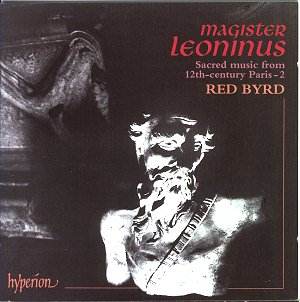There arose during the middle of the 12th
Century a school of polyphonic composition centred on the new cathedral
of Notre Dame at Paris. The achievements of the Parisian school led
by Léonin were remarkable. He composed polyphonic settings of
the solo portions of Responsaries, Graduals, Alleluias etc., writing
melismata of great length over the sustained notes of the plainsong
- the vox principalis, or as it was known, the tenor, for it hung on
to each pitch, whilst the newly composed part was known as the vox originalis
or the duplum.
So, who was Léonin, or (as he should be known by his
official Latinised title) Magister Léoninus? Well we don’t really know.
It is only through a document known as ‘anonymous IV’ c.1280 written
by a monk at the lively and intellectual monastery, [possibly one Coussemaker]
in Bury St. Edmunds that we learn of his existence. "Magister Léoninus
was the best composer of organum who composed …. to increase the divine
service." We are told that he wrote a cycle of "two-part settings
of the most important chants in the liturgical year – Christmas, Easter,
Assumption and others; this cycle was called the Magnus liber organi,
- The great book of organum" (booklet notes by Mark Everist). His
work was built upon by the better-known Perotinus (c.1160-1220) whose
music has been recorded more often including a superb disc by the Hilliard
ensemble (ECM 1385). In the past Léonin had to share a record with Perotin,
or with anon., but in recent years he has been allowed to speak for
himself. I am thinking of the ground-breaking first Léonin disc by Red
Byrd (CDA 66944) recorded in December 1996, and of a disc by Ensemble
Organum recorded in 1984 (HMCD 1148), which to my mind is much less
successful. David Munrow also tackled a handful of pieces in his ‘Music
of the Gothic Era’ recorded in 1975.
At that time Munrow could confidently write "Léonin’s
Magnus Liber consisted of thirty-four polyphonic pieces for the canonical
hours and fifty nine for the Mass itself". Present scholarship
is not so certain, and it may be best to think instead of a ‘school
of Léonin’ rather as art scholars refer to the ‘school of Giotto’ or
of ‘Simone Martini’.
What you hear in this music is an aural manifestation
of the solid and ritually ornamented rhythms of the pillars and arcades
of a 12th Century church be it in England or France. You should try
to bear in mind not the St. Denis you now know in Paris but the earlier
Romanesque building rebuilt at the end of Léonin’s life by Bishop Suger.
We can only guess at its details but enter a Cathedral, say at Elne
in Catalonia or Waltham Abbey in Essex then you have some idea of where
this music was first heard.
If you want to hear some of the earliest attempts at
two-part writing you should try ‘Anglo-Saxon Christmas’ with 10th
Century mass music from the Winchester Troper. (On Herald HAVPCD 151
directed by Mary Berry).
Red Byrd’s first disc concentrated almost entirely
on ‘Alleluya’ settings, which followed the Gradual at major feasts;
now they concentrate on the ‘Respond’. This term means responsory or
preferably the main section of a responsorial chant, as opposed to the
verse. Thus, a responsory or a Gradual consists of Respond and verse.
What makes these performances so important is the not
only the virtuosity of the two soloists but also their use of rhythm.
The situation is set out clearly in the booklet notes, and I quote.
Léonin’s duplum did two things. 1. "He laid out the lowest part
in long notes and wrote highly elaborate, rhapsodic lines above it."
And 2. " he took the long melismas of the chant and organized them
into repeating rhythmic cells and wrote a correspondingly tight rhythmic
duplum above it." This has until recently manifested itself in
dancing compound time rhythms constantly being employed. This is the
case with David Munrow’s performances (which are notated in 6/8 time)
where the long notes in the tenor are also played by a set of hand bells.
This rhythmic procedure is known as discantus. Mark Everist however
adds, "Both types exist within the same composition". Thus
is set out for us in the booklet how this works. Some sections are performed
freely; there is no sense of regular pulse or of modern-day bar-lines.
Others, often shorter, are given the regular compound time rhythms mentioned
above. These are then balanced against chunks of plainchant, sung here
by the excellent sextet of male voices Yorvox.
Ensemble Organum in their recording, which is not at
present available, put Léonin’s organum in the context of a Mass for
Christmas morning, meaning that there is yards of plainsong to negotiate.
Also with Ensemble Organum the discantus sections do not grow so naturally
out of the melismatic sections by comparison with Red Byrd.
These recordings by Red Byrd are the first to use all
of these techniques within a piece and not to set them in a liturgical
context. Not only do we have satisfactory contrasts but also the music
moves in an architectural space, aided here by the wonderful acoustic.
Volume 1 does not state its recording venue, it may well have not been
at St. Andrew's Holborn as the Cappella Amsterdam, who sang the plainsong,
appear to be microphoned rather too closely and have less air around
them. Yorvox are miked more evocatively seemingly in the chancel whereas
the soloists are in front of the nave screen. The text is always beautifully
enunciated.
For me then this is an outstanding release where scholarship
and superb vocal musicianship go hand in hand. I am left in admiration
of the entire project. However, like Frankie Dettori, whose admiration
was totally for his mount after winning the Derby, one should point
the finger of praise at the score.
Gary Higginson


